The CSS Special Solved General Science & Ability (GSA) Past Paper 2023 is Solved by Pakistan’s top GSA Coaches, Miss Iqra Ali and Sir Ammar Hashmi. They are the only coaches available in Pakistan who have solved the last 20 years’ GSA solved papers to help aspirants know how to attempt the paper to score above 80. And they have guided thousands of CSS and PMS aspirants. Both coaches have been known for their teaching methodology and imparting concepts to their students, who scored the highest marks in this subject. At the special request of CSSPrepForum, both coaches have solved the paper.

PART-II
SECTION-I
Question No. 2
(A) The age of the Universe is estimated to be 13.8 billion years. How was it estimated?
Question Breakdown:
In this question, the examiner has simply asked you to explain the methods to estimate the age of the universe. Hence, all you have to do is to start your question with a general explanation of the universe in two or three lines and directly move towards the methods with a little description of each method. Remember, some questions are so simple that no creativity also becomes creativity. Using formulas where required can help you obtain good marks.
Answer:
Define Universe
The totality of everything that exists or has existed both in space and time, including all matter and energy, planets, stars, and galaxies, is known as the Universe.
Methods to Measure the Age of the Universe
There are two methods scientists rely on for calculating the age of the universe, which are the following:
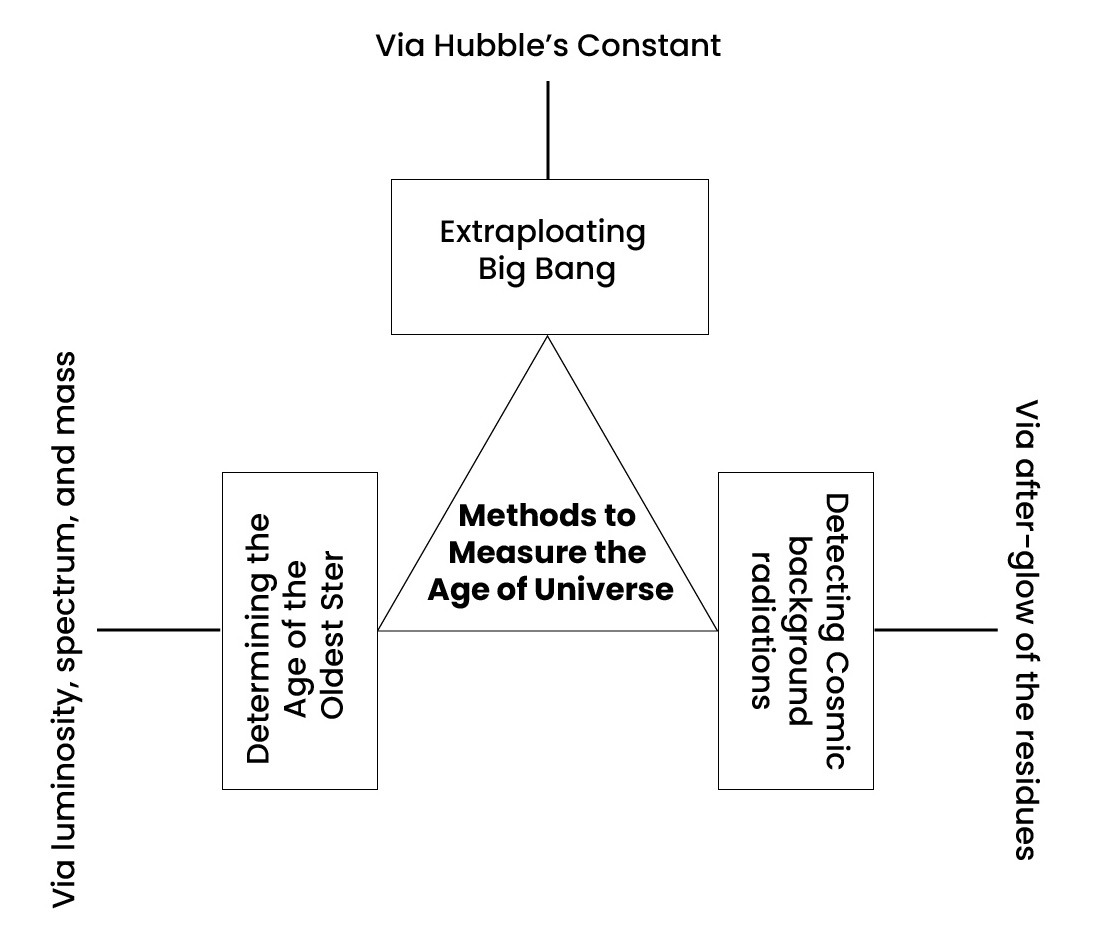
- Extrapolating Big Bang by calculating the expansion rate of the universe:
According to the scientists, the universe is approximately 14 billion years old. It is the age of the universe that is estimated from the Big Bang. According to this method, we assume that the universe is expanding at a constant rate by using Hubble’s constant (Ho).
Hubble noted that the distance of a galaxy is directly proportional to its speed, which means. The further the galaxy was, it was moving away.
d=vt
t=d/v
**v= Hod
t=d/ Hod
t=1/H
Hence, scientists were able to use the Hubble constant to estimate the age of the universe by working backwards to the Big Bang.
- By determining the age of the oldest star:
Scientists determine the age of the universe from the following
- The star’s spectrum helps determine the age of stars because blue stars tend to die faster than red Star.
- A brighter star will exhaust its energy faster than a less bright star. Therefore, the star with less luminous intensity exists for a longer time than with more luminous intensity.
- The amount of a star’s mass also helps in finding the life of a star. If a star is dense, it tends to die quickly as compared to a less dense star. Thus, the density factor also helps calculate a star’s life.
- The brighter star tends to have more energy; in turn, its speed will be greater than the comparatively less luminous star. Eventually, the brighter star will consume its energy quickly and die before the other less bright star, thus, will have a short life and vice versa.
- Cosmic microwave background (CMB) radiation:
Arno Penzias and Wilson detected cosmic background radiations while studying radio signals in 1965. The radiations are faint afterglow of the Big Bang and serve as a snapshot of the early Universe. Detailed measurements of the CMB, including its temperature and anisotropies, provide crucial information about the age, composition, and expansion history of the Universe.
The same question has been asked in General Science and Ability Paper 2018, Question no. 2(A). Therefore, do not forget to go through that too while preparing for the topic
(B) Explain the phenomenon of Solar Eclipse.
Question Breakdown:
In this question, the examiner has asked you the phenomenon of the formation of the solar eclipse. Thus, start your answer by defining Eclipse in your own words and then move towards the formation of solar eclipse. Writing the types of eclipse to clarify the formation of each type is a good approach for attempting this question. In the end, draw a schematic diagram explaining the whole phenomenon in one image.
Answer:
Eclipse
The eclipse means the obscuring of one astronomical object by another.
Solar Eclipse Formation
Solar eclipse means obscuring the Earth from the Sun’s light by the moon’s interaction between the Sun and the Earth. In other words, when moon comes between the Sun and the Earth and casts shadows across the Earth’s surface. This situation is called a solar eclipse. It can either be Complete, Partial, or Annular
- Complete solar eclipse
A total solar eclipse happens when the Moon aligns precisely between the Sun and Earth, casting its shadow on the planet. In the central part of this shadow (umbra), there is a complete blockage of the Sun, while within the broader partial shadow (penumbra), a partial eclipse is observed.
- Partial solar eclipse
A partial solar eclipse takes place when the Moon partially covers the Sun. In this phenomenon, the Moon’s darkest shadow, known as the umbra, does not completely cover the Earth. Instead, only a partial shadow, called the penumbra, falls on our planet.
- Annular solar eclipse
An annular eclipse occurs when the Moon doesn’t fully cover the Sun, creating a “ring of fire” effect due to the Moon’s greater distance from Earth during its elliptical orbit.
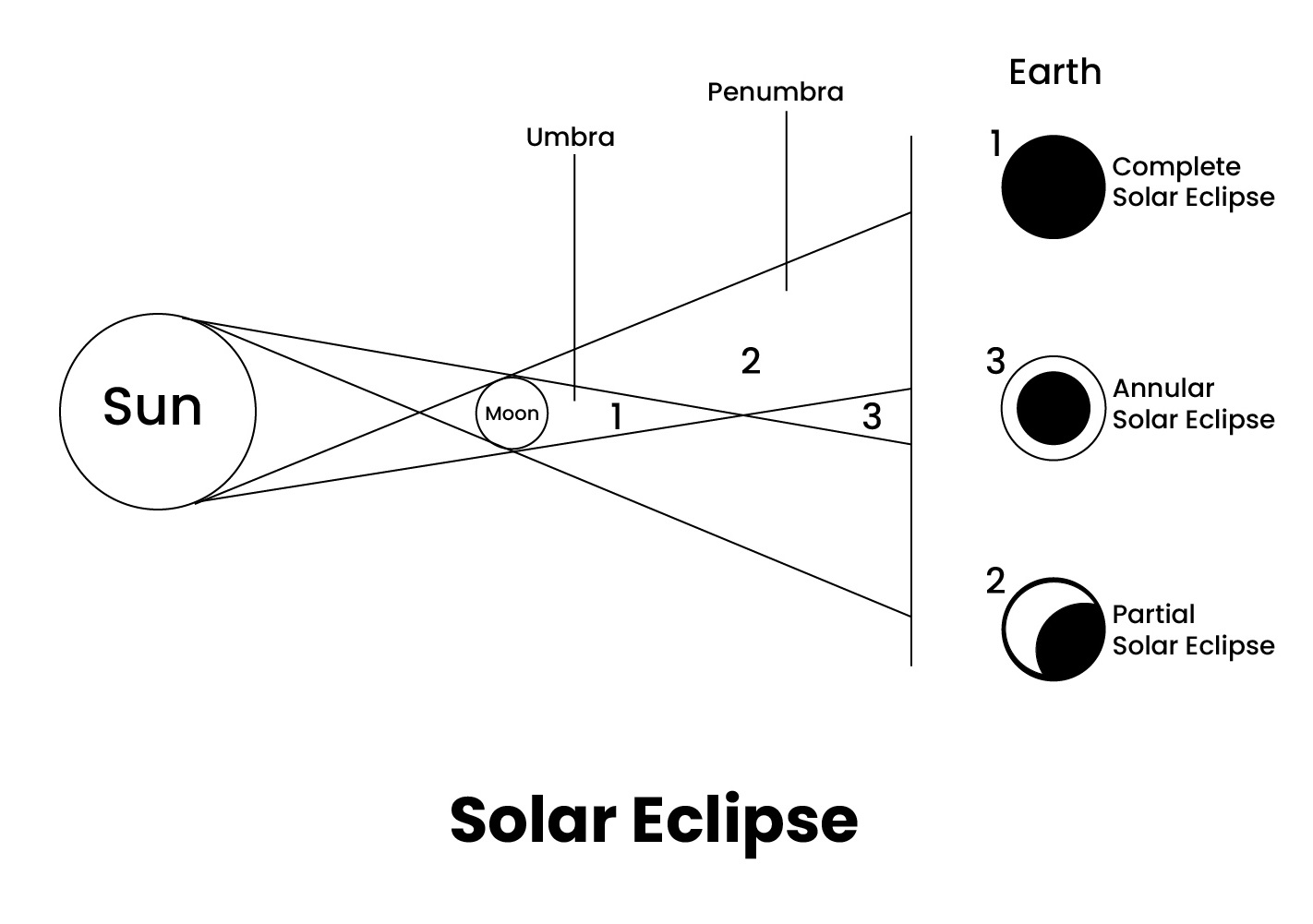
The question has been asked multiple times in many previous papers: General Science and Ability Paper 2007, Question no. 5 (B), General Science and Ability Paper 2014, Question no. 4(E), General Science and Ability Paper 2015, Question no. 3(A), General Science and Ability Paper 2017, Question no. 4(B). Thus, don’t forget to prepare this question thoroughly in all dimentions.
(C) Describe the James Webb Space Telescope, its principles of operation, construction and importance.
Question Breakdown:
Breaking the question requirements, it consists of four parts: first, understanding of the James Webb Space Telescope; second, its principle of construction; third, its construction, and fourth, its importance. Thus, keep the weightage in mind, answering each part according to two marks maximum. Remember, writing too much can downgrade your marks in the subject, so be careful. In the end, draw diagrams if required. he answer explained here is more than required for students’ ease. The weightage can be increased or decreased according to the requirement
Answer:
Define the James Webb Space Telescope
The James Webb Space Telescope (JWST) is the most powerful and complex astronomical observatory designed to explore the universe in infrared wavelengths, installed as a successor to Hubble’s Telescope. The telescope was launched on December 25, 2021, with the contribution of the Canadian Space Agency (CSA), Northrop Grumman, European Space Agency (ESA), and NASA.
Principle of Operation of James Webb Space Telescope
The JWST is primarily an infrared (IR) telescope, which means it observes the universe in the infrared portion, radiations having longer wavelengths than visible light, of the electromagnetic spectrum. Since many of the celestial objects the JWST observes emit IR radiation, and the telescope’s instruments need to operate at temperatures as low as -220 degrees Celsius (-370 degrees Fahrenheit) to avoid interference from their own heat emissions, sun shields are used to keep them away from any kind of solar radiations. The coming IR rays are then collected and focused by long primary mirrors. Such a large size allows the JWST to provide higher-resolution images than the Hubble Space Telescope. The coming light would then be analyzed by the instruments, like spectrographs to deduce results regarding distant galaxies, stars, planets, and more.
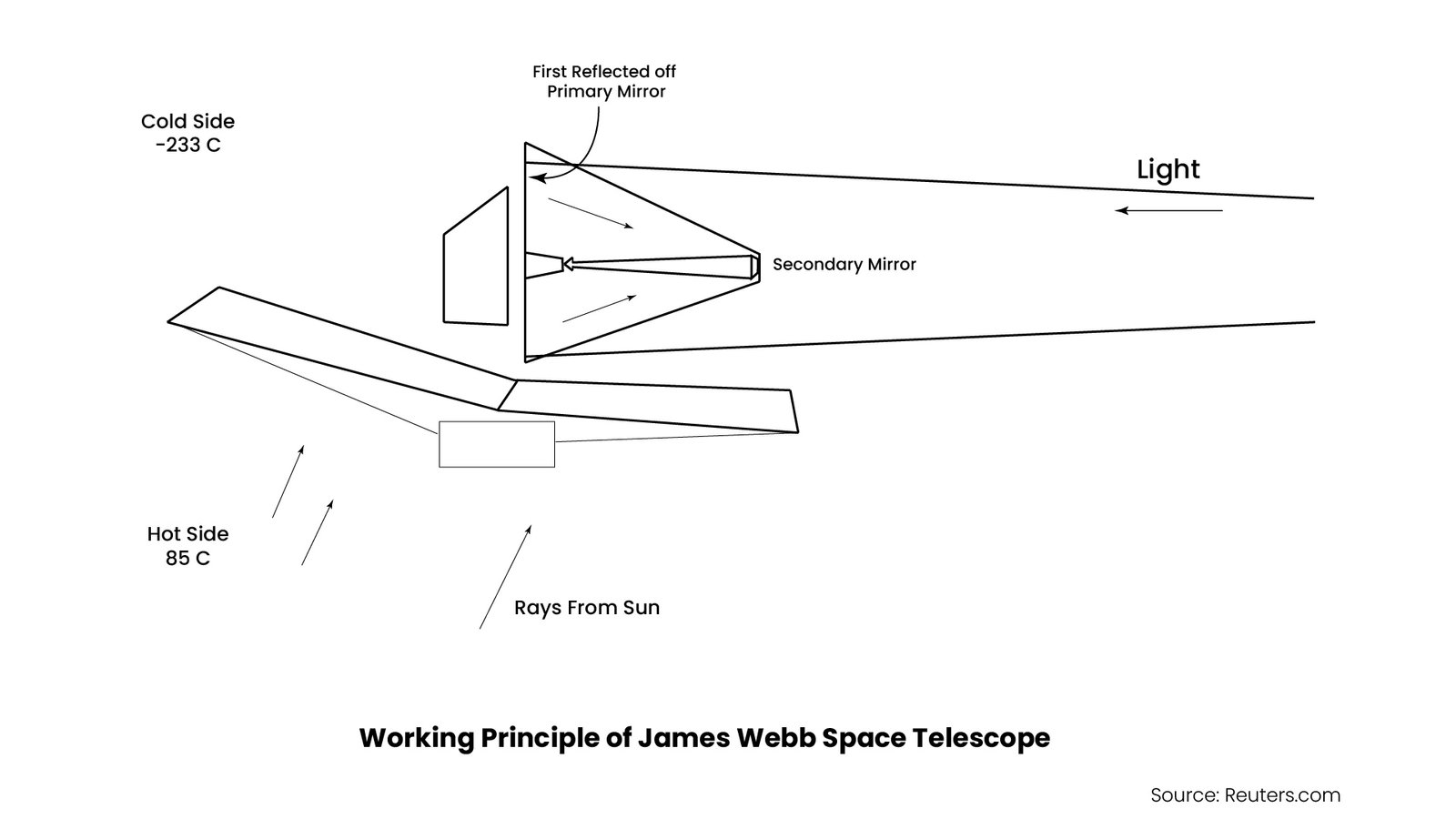
Construction of James Webb Space Telescope
James Webb Space Telescope system is comprised of
- The Optical Telescope Element (OTE) working as the eye of the Observatory. It consists of the backplane- the spine of the webb- and mirrors, gathering the light coming from space and transmitting it to the instruments in the ISIM
- The Integrated Science Instrument Module (ISIM) containing Webb’s cameras that integrate four major instruments and subsystems into one payload
- The Spacecraft Bus providing the support functions for the operation of the Observatory with the six major subsystems
- The sunshield separating the observatory into a cold anti-sun side (OTE and ISIM) and warm sun-facing side (spacecraft bus)
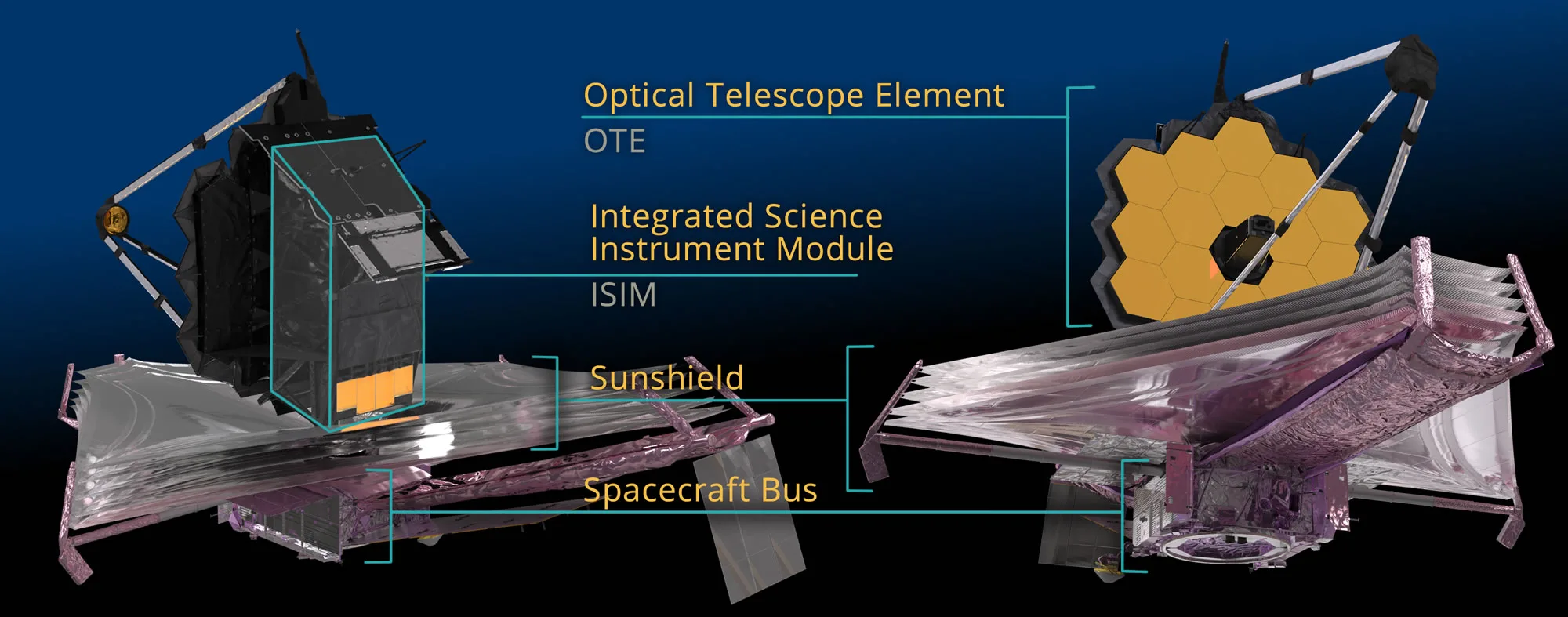
* * The diagram source: Science.NASA.gov (there is no need to draw it- only for clarification)
Importance of James Webb Space Telescope
- The JWST is designed to help astronomers study the early universe, including the formation of the first galaxies and stars.
- The telescope is capable of examining the atmospheres of exoplanets, potentially detecting signs of habitability and the presence of life-enabling conditions.
- The JWST aims to provide detailed information about star formation, stellar evolution, and the dynamics of galaxies.
- It would be used to study objects in the solar system, such as planets, moons, and asteroids, and provide valuable data for future space missions.
(D) Explain the Global Positioning System and its applications.
Question Breakdown:
The question has two parts. In the first part, the examiner has asked you to briefly describe the Global Positioning System (GPS), with its applications. So, start your answer with its definition in your own words. When done, move towards the next part, which is about the working of GPS. Explain its working alongside the segments which are responsible for its working. Lastly, address the second part, by explaining its applications. You can draw a schematic diagram to make your paper more appealing.
Answer:
Global Positioning System:
Geo Positioning System, GPS, is a space-based navigation technology that provides the pinpoint location, velocity, and time – 24 hours a day- of anything on the earth with ultra-high accuracy. Although the GPS project has been started by the US Defense Department in 1973 for military operations, it has not been in the mainstream until 2007.
Working of GPS:
Mainly, the GPS has three fundamental segments:
- Satellites
- Receivers
- Control systems
Almost 31 satellites orbit around the Earth at different angles collecting data from all over the earth; they continuously emit radio signals. In response to the approaching signals, the portable receivers, for instance, your mobile phone become active and measure the time and location of the satellites. The distance is then measured by triangulation, tri referring three, as three minimum satellites are always required to produce accurate signals. Meanwhile, the control systems are responsible for the proper functioning of the entire GPS by tracking, controlling, and communicating with the satellites.

Applications of GPS:
- GPS is widely used in navigation in devices like smartphones, standalone GPS units, and in-car navigation systems to provide real-time location information and directions to users.
- Another field where GPS is used is aviation. Most contemporary aeroplanes are equipped with multiple GPS receivers, offering pilots and passengers real-time information on the aircraft’s location and flight paths.
- When high-accuracy GPS is fitted on ships and boats, it allows captains to navigate through unfamiliar shipping channels, harbours, and waterways without hitting known obstacles or running aground.
- In farming, GPS receivers on tractors and other agricultural equipment help farmers map their plantations and ensure that they return to exactly the same areas when sewing their seeds in future, also known as precision agriculture.
- The military uses GPS in search and rescue operations. In fact, it was first designed by the United States Department of Defence to assist the military. It aids the army in determining the precise location of a soldier in distress, whether lost in the wilderness or caught in an emergency situation at sea, which helps to manage resources and protect soldiers on the ground.
The same question has been asked in General Science and Ability Paper 2020, Question no. 5(D). Therefore, do not forget to go through that too while preparing for the topic.

Question no. 3
(A) What is a “Weather Cycle’? Describe its causes and parts.
Question Breakdown:
In this question, the examiner has asked you to explain the term “weather cycle.” However, it is an interchangeable term of “Weather Pattern.” So, you are supposed to decode the question accordingly. To answer this, first, define Weather and weather patterns. Then, simply explain its causes and parts briefly. No diagram is required, but you can draw keys if you want to. The answer explained here is more than required for students’ ease. The weightage can be increased or decreased according to the requirement.
Answer
Define Weather Cycle
Weather cycles are recurring changes in atmospheric conditions. Caused by movements and chemical changes in air pressure, ocean currents, sunlight, and other natural factors, weather cycles have been fairly predictable, as evidenced by the seasons of the year. They lead to changes in the environment, such as the melting of sea ice and permafrost.
Factors Causing Weather Cycle
- Solar Radiation
The amount and intensity of solar radiation that reaches the Earth’s surface vary throughout the year due to the tilt of the Earth’s axis. This variation leads to seasonal changes, such as the changing of the seasons.
- Ocean Currents:
Ocean currents, such as the El Niño and La Niña phenomena, have a significant impact on regional weather patterns. El Niño and La Niña are two opposing patterns that break the normal conditions, occurring every two to seven years. Episodes of El Niño and La Niña typically last nine to 12 months, but can sometimes last for years. These currents can influence temperature and moisture distribution in the atmosphere, leading to periodic weather cycles.
- Seasonal Changes:
The Earth’s axial tilt causes the changing of seasons, which in turn leads to seasonal weather cycles. Summer and winter solstices and the vernal and autumnal equinoxes mark significant points in these cycles.
- Atmospheric Pressure Patterns:
High and low-pressure systems, such as the North Atlantic Oscillation (NAO) and the Pacific Decadal Oscillation (PDO), affect weather patterns over extended periods. These pressure systems can lead to alternating periods of storminess and calm weather.
Parts of Weather Cycle
- Temperature: Temperature is a fundamental component of the weather patterns. It varies throughout the day and across seasons, affecting the type of weather experienced.
- Pressure: High-pressure systems often bring fair and stable weather, while low-pressure systems are associated with stormy and unsettled conditions, influencing weather cycle.
- Humidity: High humidity levels can lead to the formation of clouds and precipitation, while low humidity can result in clear skies and dry conditions.
- Wind: Wind is the movement of air in the atmosphere. Wind patterns influence weather by carrying air masses, moisture, and temperature changes across regions.
- Precipitation: Precipitation includes various forms of moisture falling from the atmosphere, such as rain, snow, sleet, and hail. Precipitation is a key part of the weather cycle and has a significant impact on daily weather patterns.
(B) What is Air Pollution”? Discuss its causes and measurement methods. Name the countries with the highest and lowest percentage of it.
Question Breakdown
In this question, the examiner has asked you to explain Air Pollution with its causes, measurement methods, countries with its highest concentration and countries with its lowest concentration. Analyzing the question it has five parts with five marks in total; hence, each part carries only one mark. The answers here are still more than necessary only for the ease of students. Students must know how much the examiner is asking and answer accordingly.
Answer
Define Air Pollution
Air pollution happens when the composition of the air changes, whether it’s in terms of volume or alterations in its chemical, physical, or biological characteristics. The atmosphere consists of a delicate equilibrium of elements and particles, and any disruption, no matter how slight, can have harmful effects on living organisms, such as animals and crops.
According to the World Health Organization (WHO), “Air pollution is contamination of the indoor or outdoor environment by any chemical, physical or biological agent that modifies the natural characteristics of the atmosphere.”
Pollutants Responsible for Air Pollution
- Particulate matters
- Volatile Organic Compounds
- Nitrogen dioxide (NO2)
- Sulfur dioxide (SO2)
- Carbon Monoxide (CO)
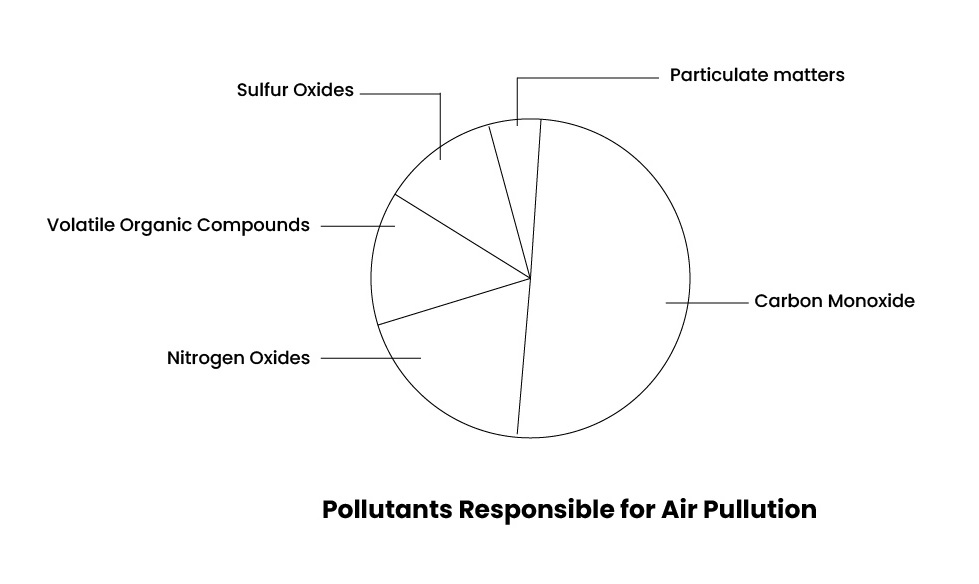
Causes of Air Pollution
- Burning of Fossil Fuels
- Vehicles and Transportations
- Industrial Emission
- Solid Waste Disposal
- Domestic Activities
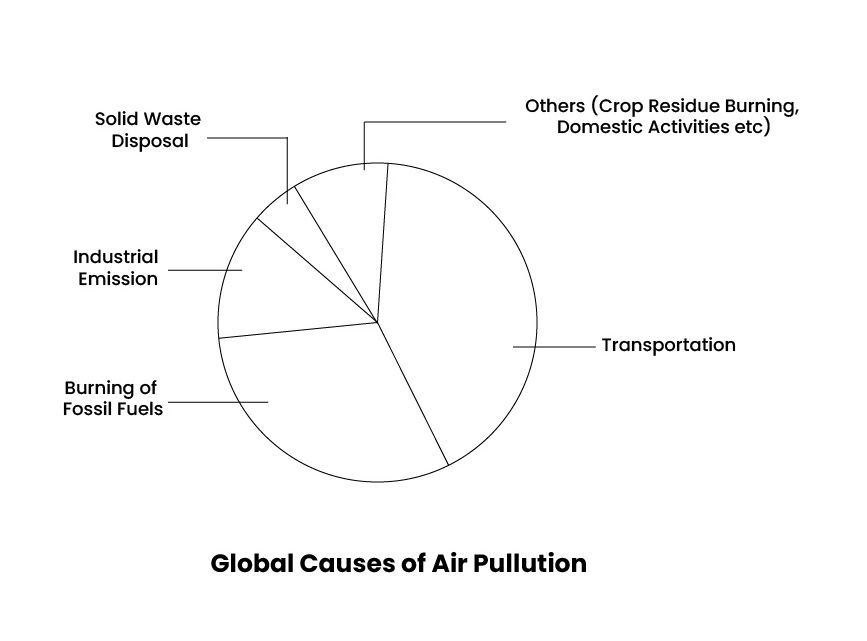
Measurement Methods of Air Pollution
Air pollution can be measured in many different ways, a few important among which are mentioned below.
- Air Quality Index (AQI)
The United States Environmental Protection Agency’s Air Quality Index, commonly known as AQI, employs a numerical system to gauge air pollution levels within a particular locale. A higher numerical value corresponds to worse air quality.
- Air Emissions Monitoring
Air emissions monitoring is the gathering and interpretation of information to determine whether EPA regulatory requirements are being met. The EPA quantifies two types of monitoring: Ambient Air Quality Monitoring and Stationary Source Emissions Monitoring.
- Air Quality Sensors
These are small devices that collect comprehensive data on the concentration of key gas pollutants such as NO2, O3, SO2, and CO. Sensors offered by Airly measure air pollution with the use of laser and electrochemical methods.
Country with the Highest Percentage of Air Pollution
According to the IQAir 2022 World Air Quality Ranking, the country with the highest air pollution is Chad, with an average PM 2.5 concentration of 89.7.
Country with the Lowest Percentage of Air Pollution
According to the IQAir 2022 World Air Quality Ranking, the country with the lowest air pollution in Iceland.
(C) Write a comprehensive note on ‘Pole Reversal of Earth.
Question Breakdown
In this question, the examiner has asked you to write down the note on “Pole Reversal of Earth.” Whenever the question demands “Note,” it is up to you how you decode it. You can start by writing the definition of the term, discovery, theory, if any, and implications. Remember to avoid writing too much, as it will do nothing but downgrade your marks. Stay relevant and clear.
Answer
Understanding Pole Reversal of Earth
The pole reversal of Earth, also called the magnetic field reversal, is significant geological events where the Earth’s magnetic field changes direction. During the reversal, Earth’s magnetic south and north poles swap their locations. Although it may seem strange, such magnetic reversals have remained common in Earth’s geologic history. According to the Paleomagnetic records, Earth’s magnetic poles, on average, reverses every 200,000 to 300,000 years.
Evidence of Pole Reversals
Over three million years, the magnetic pole has reversed 12 times as recorded by the reversals in iron-rich rocks that behave like magnets. When molten rock, particularly basaltic magma rich in iron, solidifies, the magnetic minerals within it align with the Earth’s magnetic field at that moment. As it solidifies, it locks the magnetic field orientation like a tiny compass, and the effectiveness “locks in” the orientation of the Earth’s magnetic field within the rock. Scientists found that the magnetic orientation switched in successive basaltic lava layers using magnetometers, which inform that magnetic poles have reversed in history.
Possible Effects of Pole Reversals
- In a worst-case scenario, a pole reversal could weaken the Earth’s magnetosphere, leaving us vulnerable to cosmic radiation by temporarily disrupting the shield that protects us from harmful solar radiation.
- A rapid pole shift might temporarily disable our magnetosphere, making it unable to shield us from large solar storms. This scenario could damage power grids, causing massive power losses and substantial financial costs.
- While concerns exist, there is no conclusive evidence that the magnetosphere would completely fail. Instead, a shift might result in slightly increased radiation levels, mainly affecting satellites and objects at higher altitudes. It could also make auroras visible at lower latitudes.
- Pole reversal could confuse animals that rely on the Earth’s magnetic field for navigation. This added confusion, coupled with existing threats from human activities, could be devastating to endangered species.
- Water displacement due to climate change, including melting polar ice caps and increased water evaporation, could impact the planet’s magnetic fields by shifting its axis in response to these changes, affecting Earth’s magnetism.
(D) Describe different Ocean Currents, their causes and their effects on Climate.
Question Breakdown:
In this question, the examiner has asked you to explain Ocean Currents with its causes and effects. To answer this, first start with the definition and the importance of Ocean Currents. When done, move to the next part, explaining the reasons behind the ocean currents and how they are impacting human lives. Draw a diagram explaining the whole procedure. The answer explained here is more than required for students’ ease. The weightage can be increased or decreased according to the requirement.
Answer:
Define Ocean Currents
The movement of ocean water driven by wind patterns, differences in water temperature and salinity, the shape of the ocean basins, and the Earth’s rotation are called ocean currents. In the area where there is a warm ocean current, the climate is warmer. Likewise, the climate is colder where there is a cold current.
Different Ocean Currents
The Ocean currents are mainly divided into two categories: cold water currents and warm water currents, distributed throughout the world, including
- The Pacific Ocean is the largest ocean in the world. Its total area is more than the combined land area of the earth.
- The Atlantic Ocean is the second-largest ocean in the world. Its shape is a lot like the English letter S. The Atlantic Ocean is bordered by Europe, Africa to the east, North and South America to the west, the Arctic Ocean to the north, and the Antarctic Ocean to the south.
- The Indian Ocean is shaped like a triangle. The Indian Ocean is surrounded by land in the northern part. So, with these changes in seasons, the speed of ocean currents also changes a lot.
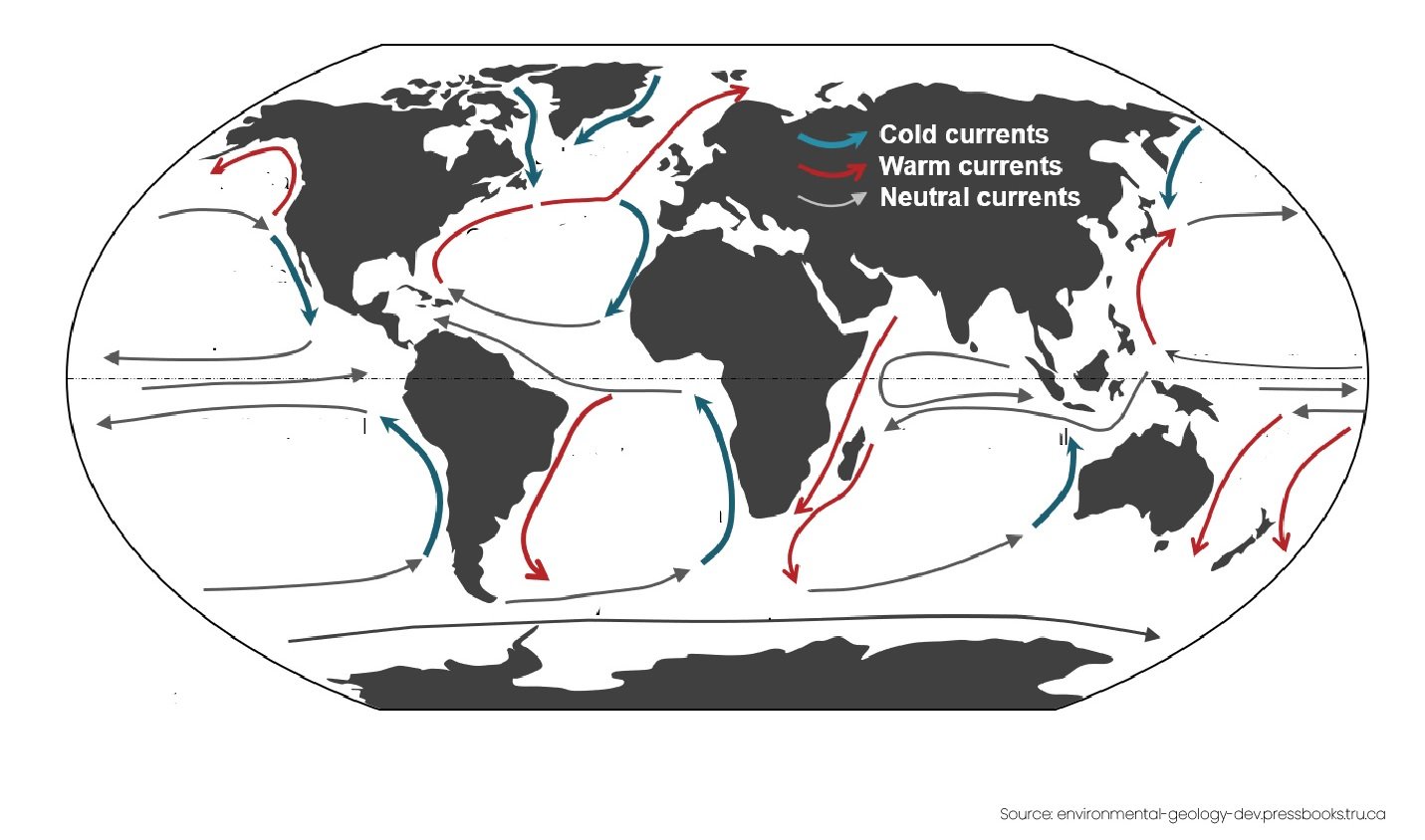
Causes of Ocean Currents
The major causes of ocean currents include
- Planetary Winds
Primary ocean currents are generated by the influence of planetary winds. As these winds pass over the ocean, they propel the water’s movement in the direction of their own flow.
- Earth’s Rotational Speed
The rotation of the Earth affects the course of ocean water movement. In the Northern Hemisphere, the water veers rightward, and in the Southern Hemisphere, it veers leftward due to the Earth’s rotation. This phenomenon is responsible for the development of ocean currents.
- Seawater Temperature
Variations in seawater temperature play a key role in ocean current formation. Warmer water in equatorial and tropical regions, due to higher temperatures, rises to create surface currents that flow towards cooler Polar Regions. To compensate for the warm water loss, cold, denser water flows from Polar Regions to the tropics as subsurface currents. In this way, both warm and cool ocean currents are established.
- Changes in Seawater Salinity
Less saline water, being lighter, forms surface currents, moving towards areas of higher salinity or denser water. To balance this salinity difference, more saline water flows towards the less salty water as subsurface currents.
- Continental Location and Shape
Ocean currents are constrained more near coastlines and islands than in open ocean areas, often due to the influence of continents.
Effects of Ocean Currents on Climate
- Temperature Moderation
Ocean currents play a critical role in regulating Earth’s climate, moderating temperatures and influencing weather patterns through the movements of warm air towards cold poles and vice versa.
- Rainfall and Snow
Due to the presence of water vapour in the air flowing over the warm currents, rain falls when the air flows over the land surface. But the air flowing over the cold currents does not rain because it is dry. However, there is occasional snowfall.
- Increase Coastal Productivity
Due to the effect of warm ocean currents, the coastal ports are ice-free in winter. For instance, due to the warm North Atlantic Ocean currents, most of the ports in the British Isles can be used all year round.
- Creation of Catastrophic Weather
Normally, in areas where warm and cold currents meet, there is dense fog and strong storms due to the difference in temperature. If there is difficulty in the movement of ships and aircraft
- Biodiversity Distribution
Ocean currents influence the distribution of marine species by affecting larval transport and migration patterns. Warm currents can carry species from one region to another, promoting genetic diversity and supporting biodiversity.

Question no. 4
(A) Write a note on data storage in a ‘USB’. How is it different from the Hard disk?
Question Breakdown:
The question consists of two parts. In the first part, the examiner has asked you to write down the note on data storage in a USB. When the examiner asks for a note, it is up to you how you decode it. In the next part, the question defines the difference between the data storage of a Hard Disk and USB. So, here, you can elaborate on the difference in table form, too.
Answer:
Define USB
USB, full form being Universal serial bus, flash drive is an external or secondary storage device that is used to hold and transfer data easily from computer to computer. It works by storing data on flash memory and transferring it through USB ports. It is typically removable, rewritable, and much smaller than optical and magnetic storage devices.
Data Storage in USB
USB uses flash memory for storing and retrieving data. Technically, data saved in a USB drive is stored on a NAND flash memory chip, which is a type of non-volatile memory that retains stored data even when the power is turned off. Flash memory relies on two essential transistors: the “Control gate” and the “Floating gate”.
The Floating gate, located above a silicon substrate, serves as the data storage site where the data is organized into blocks, and each block can be read or written to individually. This non-conductive layer protects the stored data, making it non-volatile.
When data is saved on a flash drive, a voltage is applied to the Control gate, causing electrons to flow from the Source to the Drain. During this process, electrons gain energy and become stored in the Floating gate, forming a negative charge to represent data. This non-volatile storage ensures data retention even without power, making flash memory a reliable data storage technology. The controller also handles error correction, wear levelling, and other functions to ensure that the data is stored and retrieved correctly.

The Difference in the Data Storage in USB and Hard Disk
| Characteristics | Hard Drives | USB Flash Drives |
| Type | A type of electromechanical storage device. | A type of semiconductor storage device. |
| Data storage | Stores data in spinning disks with the help of a read/write head | Stores data in cells of a semiconductor memory chip. |
| Storage capacity | High storage capacity | Smaller memory capacity |
| Cost | Less expensive | More expensive |
| Power consumption | Consume more power | Consume comparatively less power |
| Physical size & weight | Larger and heavier | Smaller and lighter |
| Portability | Non-portable storage drives | Portable storage devices |
| Security | Less secure to malicious programs like virus | Enhanced security measures like data encryption, etc |
| Sensitive to Physical Damages | More sensitive to physical damages | More durable and less sensitive |
| Noise | Have moving parts, hence produce noise while operating | Do not produce noise while operating due to the absence of moving parts |
| Speed | Hard drives are slower. | Flash drives are faster. |
| Need of power source | Requires a power source to trigger its drive circuit | Does not require an additional power source |
| Applications | Best suited for large-volume data storage in computers | Used for both data storage and data transfer from one computer to another |
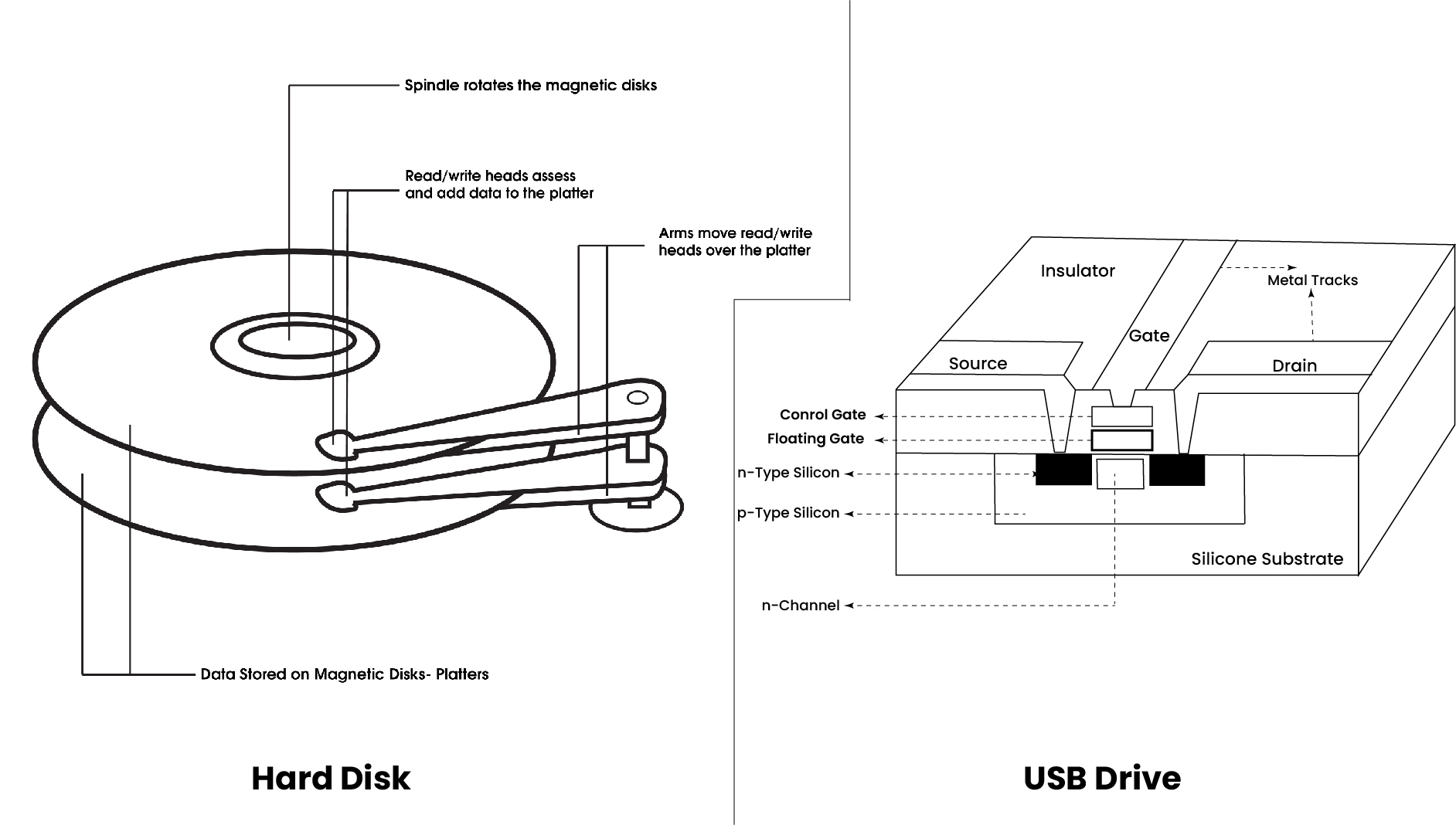
The same question has been asked in a different way in the General Science and Ability paper 2018, Question No. 5 (A). Therefore, do not forget to prepare that alone.
(B) Describe how a ‘Solar Cell” converts light into electricity. Describe its construction, operation, and applications.
Question Breakdown:
In this question, the examiner has asked you to describe the construction, working principle, operation, and applications of Solar Cells in detail. So, to answer this question, first, give a general explanation of Solar Cells. Then, move towards answering all other parts one by one. Remember, in any question where the construction of the working principle of a machine or technology is asked, you are required to draw a schematic diagram to explain your answer. The block diagram is also a good approach if you cannot draw complicated diagrams.
Answer:
Define Solar Cell
A solar cell, also known as a photovoltaic cell, is an electronic gadget that transforms the energy from light into electricity directly through a physical phenomenon called the photovoltaic effect. It belongs to the category of photoelectric cells, which are devices whose electrical attributes like current, voltage, or resistance change when they encounter light. Typically, these individual solar cell devices serve as the fundamental components of photovoltaic modules, commonly referred to as solar panels.
The Conversion of Solar Energy into Electricity through Solar Cell
- Construction
- The principal layer of the cell is an outer-most anti-reflective cover glass layer that allows light to penetrate and reach the junction.
- Thin metal contacts are applied to the top and bottom of the cell to allow for the collection of electrical current.
- The middle layer of the photovoltaic or solar cell is composed of two layers of semiconductor materials made of P-type and N-type Materials, which create a junction, typically a silicon PN junction. The P side is positively charged, while the N side is negatively charged.
Solar cells are commonly manufactured in the form of flat disks or strips to maximize their surface area. While germanium and silicon are frequently used as semiconductor materials in solar cells, modern applications also employ materials like gallium arsenide, indium arsenide, and cadmium arsenide.
- Working Principle of Operation of Solar Cells
In solar cells, the layer of P material is intentionally thin to enable easy access to light, ensuring that photon energy can readily reach the junction, facilitating the photovoltaic effect. When light with an appropriate frequency falls on the upper layer of the junction, its electrons absorb photon energy, breaking away from their parent atoms and crossing the junction. The process results in the generation of free electrons and holes on both sides of the junction. It’s worth noting that holes move in the opposite direction to electrons. This continues until a potential difference is established parallel to the cell due to the accumulation of negative ions on one side of the junction and positive ions on the other side. These conditions yield the maximum voltages generated by a photovoltaic cell. To achieve higher voltages, multiple solar cells can be connected in series, whereas adjusting the current is feasible by connecting cells in parallel. Keep in mind that the current generated by a solar cell is directly proportional to the amount of illumination it receives and depends on the cell’s surface area. Furthermore, the power output of the cell is contingent on the level of sunlight. In the end, the metal contacts on the top and bottom of the cell collect the flow of electrons and provide a path for the electrical current to be used for external applications.

Applications of Solar Cells
- Solar cells are used in solar panels to generate electricity for homes, businesses, and other buildings.
- Small solar cells are used in portable devices such as power calculators, wristwatches, and solar chargers for electronic gadgets.
- Solar cells are used to provide electricity in remote or off-grid areas where traditional power sources are not available.
- Solar cells are crucial for space exploration and satellites. They provide power for spacecraft, rovers, and space stations by converting sunlight into electricity in the vacuum of space.
- Solar cells are used in solar water heaters to convert sunlight into heat energy for heating water in homes and businesses.
(C) Write a comprehensive note on the ‘Food cycle in our body’.
Question Breakdown:
In this question, the examiner has asked you to explain the pathway of food in the human body. Thus, in short, you are supposed to explain the process of digestion, from ingestion to excretion, along with the mechanisms involved, like absorption and transportation. Remember, while answering your question, you are supposed to use the given jargon rather than the relevant ones to keep your answer more relevant and connected. So, first, you would define the “Food Cycle” and then explain the components of the food cycle step by step with a detailed diagram.
Answer:
Define Food Cycle
The food cycle in human body, also known as the digestive process, is a complex and highly coordinated system that allows us to obtain essential nutrients and energy from the food we consume. The process involves the ingestion, digestion, absorption, Assimilation and egestion of food.
Structure of Digestive System of Humans
The digestive system of man consists of
- The oral or buccal cavity
- Esophagus
- Stomach
- Small intestine (duodenum, jejunum and ileum)
- Large intestine (ascending colon, transverse colon, descending colon, caecum and rectum).
- Glands at various regions, especially salivary glands, liver and pancreas
The Process of Food Cycle
- Ingestion
The food cycle begins with ingestion, where we take in food through our mouth. It is the initial step, and it involves the mechanical breakdown of food into smaller pieces through actions like chewing and mixing with saliva. Saliva contains enzymes, such as amylase, that start the digestion of carbohydrates.
- Digestion
Once the food enters the stomach, it goes through both mechanical and chemical digestion. Mechanical digestion involves the churning and mixing of food by stomach muscles, creating a semi-liquid substance known as chyme.
Chemical digestion primarily occurs in the stomach and small intestine. In the stomach, gastric juices, which are highly acidic, break down proteins. The stomach also releases the enzyme pepsin for protein digestion. The chyme is then released into the small intestine, where most of the digestion and nutrient absorption takes place. The pancreas secretes digestive enzymes like amylase, lipase, and trypsin, which further break down carbohydrates, fats, and proteins.
The small intestine is also lined with tiny hair-like structures called villi, which increase the surface area for absorption.
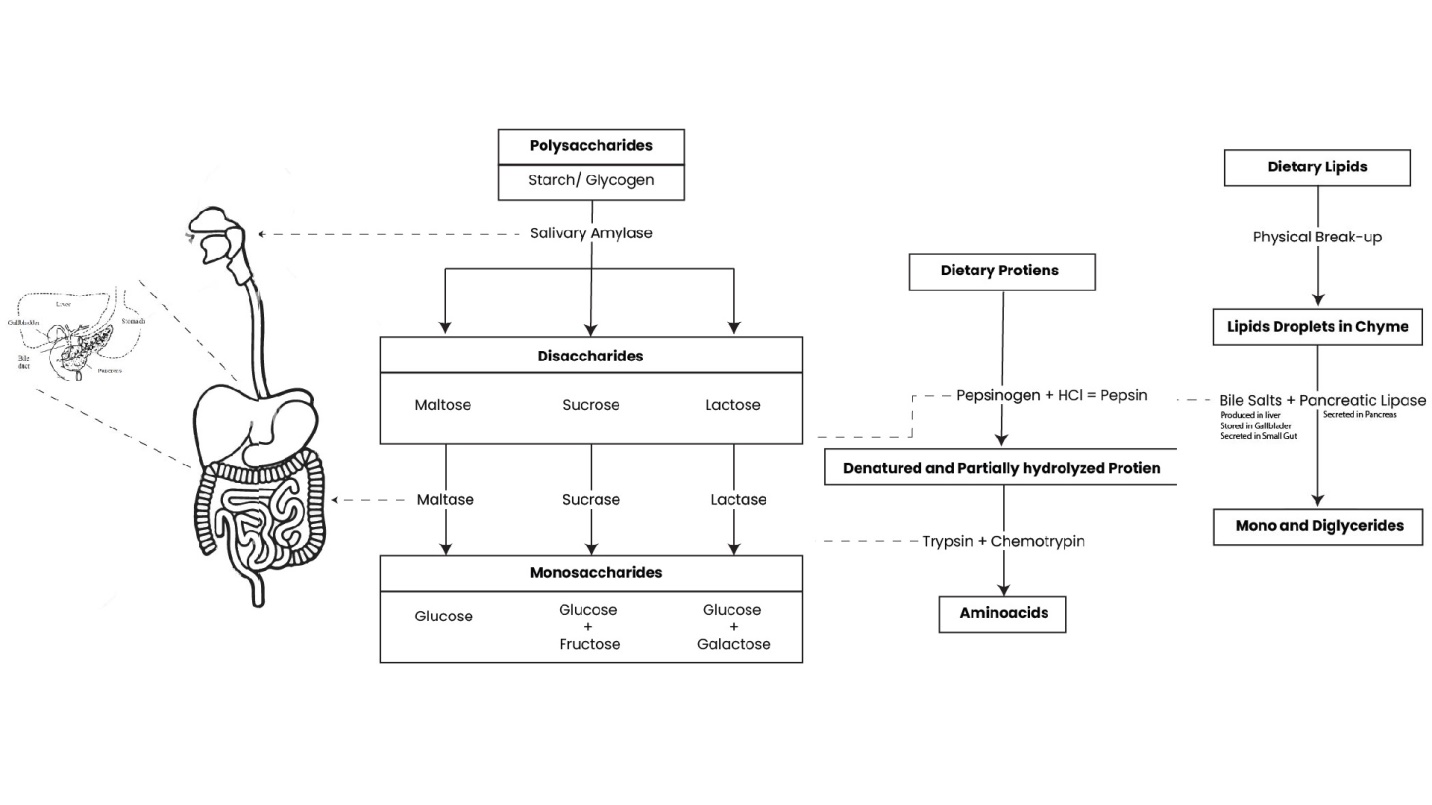
- Absorption
The small intestine is the primary site of nutrient absorption. Nutrients, including amino acids, fatty acids, glucose, vitamins, and minerals, are absorbed into the bloodstream through the villi.
- Assimilation
The absorbed nutrients are transported to various cells and tissues in the body to be used for energy, growth, and repair. Water and electrolytes are also absorbed in the small intestine to maintain proper fluid balance in the body.
- Egestion
What remains after digestion and absorption is a mixture of indigestible substances, fiber, and waste products. This material, known as feces, is moved into the large intestine (colon) where water and electrolytes are reabsorbed, converting it into a more solid form. Feces are then stored in the rectum until they are eliminated from the body through the anus in the process of defecation.
(D) What is Artificial Intelligence”? How is it helpful for humanity?
Question Breakdown:
In this question, the examiner has asked you to explain the term “Artificial Intelligence” in the first part and the benefits of AI in the second part. Thus, the answer would be quite simple. Just define AI in your own words and give benefits. Do not forget to give an example while explaining the uses to gain maximum marks, as it is the only requirement of the question. In the end, you can draw a chart to clarify your question if necessary.
Answer:
Define Artificial Intelligence:
It is the study of intelligent machines capable of performing the same kinds of functions that characterize human thoughts.
Discovery of Artificial Intelligence
The term Artificial Intelligence was coined by John McCarthy in 1956 at the Dartmouth conference, Massachusetts Institute of Technology (MIT).
Two subsets under the term AI:
- Machine Learning
- Deep Learning
Uses of Artificial Intelligence for Humanity
Artificial Intelligence has numerous benefits, a few of which are given below
- AI in Medicine
- AI has revolutionized medicine with advanced diagnostics, using highly accurate scans such as mammography, computed tomography, and echocardiography to predict conditions like breast cancer and stroke.
- Machine learning in AI enables personalized healthcare, allowing individuals to monitor their well-being through devices like smartwatches and phones, providing personalized data for early anomaly detection.
- AI in Economy
- AI’s rapid computational capabilities enhance data assembly and transfer, potentially doubling economic growth.
- AI’s influence extends across production sectors, generating new revenue streams and accelerating economic growth on a global scale.
- AI in Military
- AI aids in intrusion detection and penetration testing to protect critical cyber networks, ensuring information availability, integrity, and confidentiality.
- AI finds applications in reconnaissance, threat evaluation, intelligence analysis, command and control systems, and military education, bolstering national defence strategies.
- AI in Climate Change Mitigation
- AI utilizes satellite and aerial imagery to detect deforestation, providing essential data for informed policymaking to address climate change-related weather fluctuations.
- AI assists in monitoring hazardous emissions from coal plants, encouraging the energy industry to halt the installation of carbon energy plants for environmental preservation.
- AI in Agriculture:
- AI revolutionizes agriculture with autonomous robots handling tasks like crop harvesting at a rapid pace, surpassing human labour capabilities.
- Computer vision algorithms and drones enable the monitoring of crop and soil health, detecting issues like soil deficiencies and pests for improved crop yields.

The same question has been asked in a different way in the General Science and Ability Paper 2016, Question No. 3 (A), General Science and Ability Paper 2018, Question No. 5 (D), and the General Science and Ability Paper 2022, Question No. 5 (D). Therefore, do not forget to prepare that alone.
Question no. 5
(A) Explain the concept of Diabetes, its causes and classifications in the human body.
Question Breakdown:
In this question, the examiner has asked you to explain the concept of the disease “Diabetes” with its causes and classification. It is quite a simple question requiring a direct answer without many details. However, adding a few stats on the distribution of the disease with special reference to Pakistan or the world while dealing with such a question can leave a good impression. But again, avoid writing too much; a graph, chart or map is enough.
Answer:
The Concept of Diabetes
- Define Diabetes
Diabetes is a chronic medical condition that arises when the pancreas fails to generate sufficient insulin- a hormone responsible for regulating blood glucose levels, or when the body is unable to efficiently utilize the insulin it produces.
- Global Distribution of Diabetes
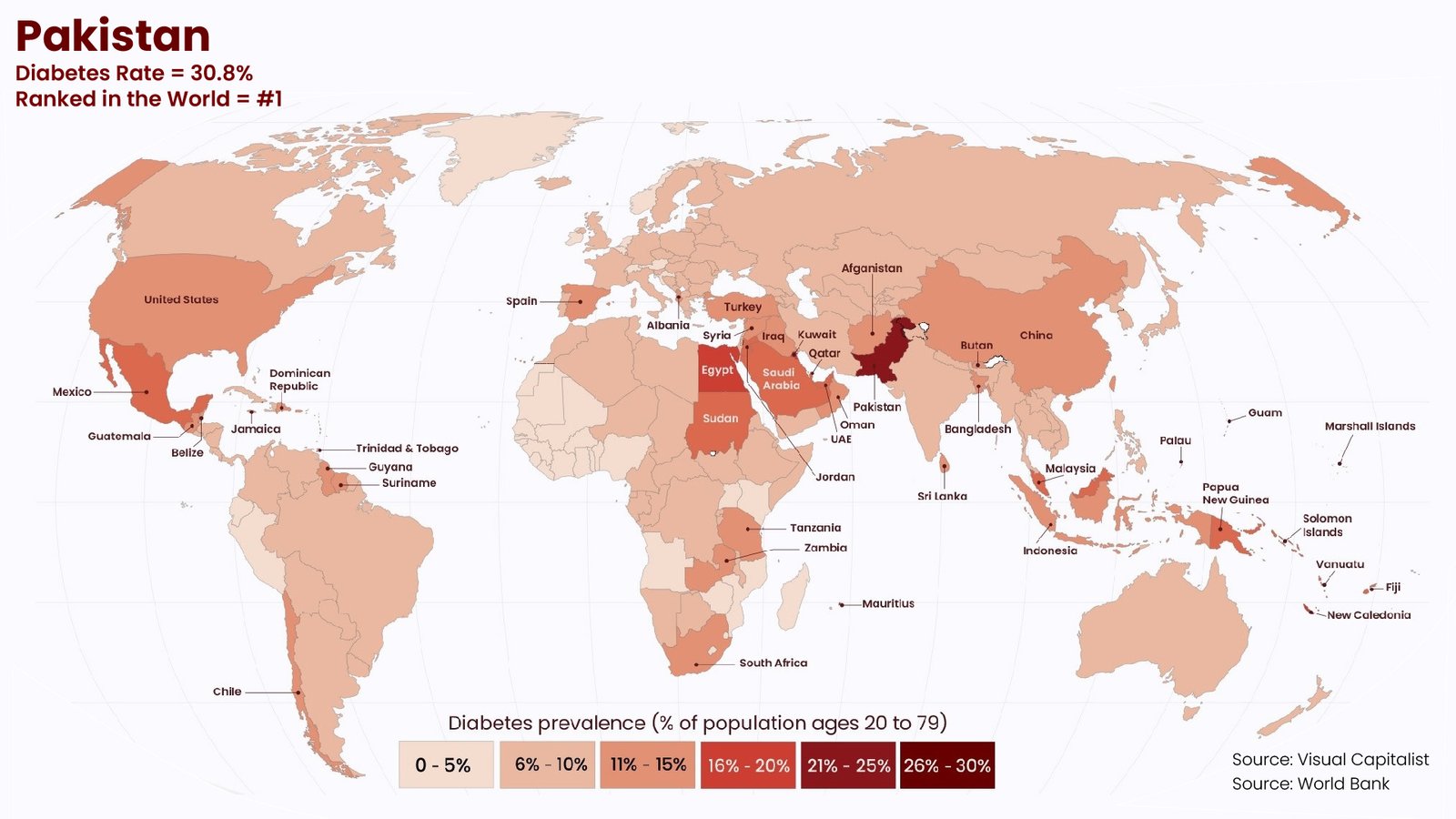
Classification of Diabetes
According to the World Health Organization (WHO), the classes of Diabetes Includes
- Insulin-dependent DM (IDDM, Type 1): β-cell destruction – mostly immune-mediated- an absolute insulin deficiency; onset most common in childhood and early adulthood
- Non-insulin-dependent DM (NIDDM, Type 2): The most common type, various degrees of β-cell dysfunction and insulin resistance, commonly associated with overweight and obesity
- Hybrid forms of Diabetes:
- Slowly evolving, immune-mediated Diabetes of adults
- Ketosis-prone type 2 diabetes
- Other specific types
- Gestational Diabetes Mellitus (GDM)
- Diabetes Mellitus in Pregnancy
- Impaired Glucose Tolerance (IGT)
Causes of Diabetes
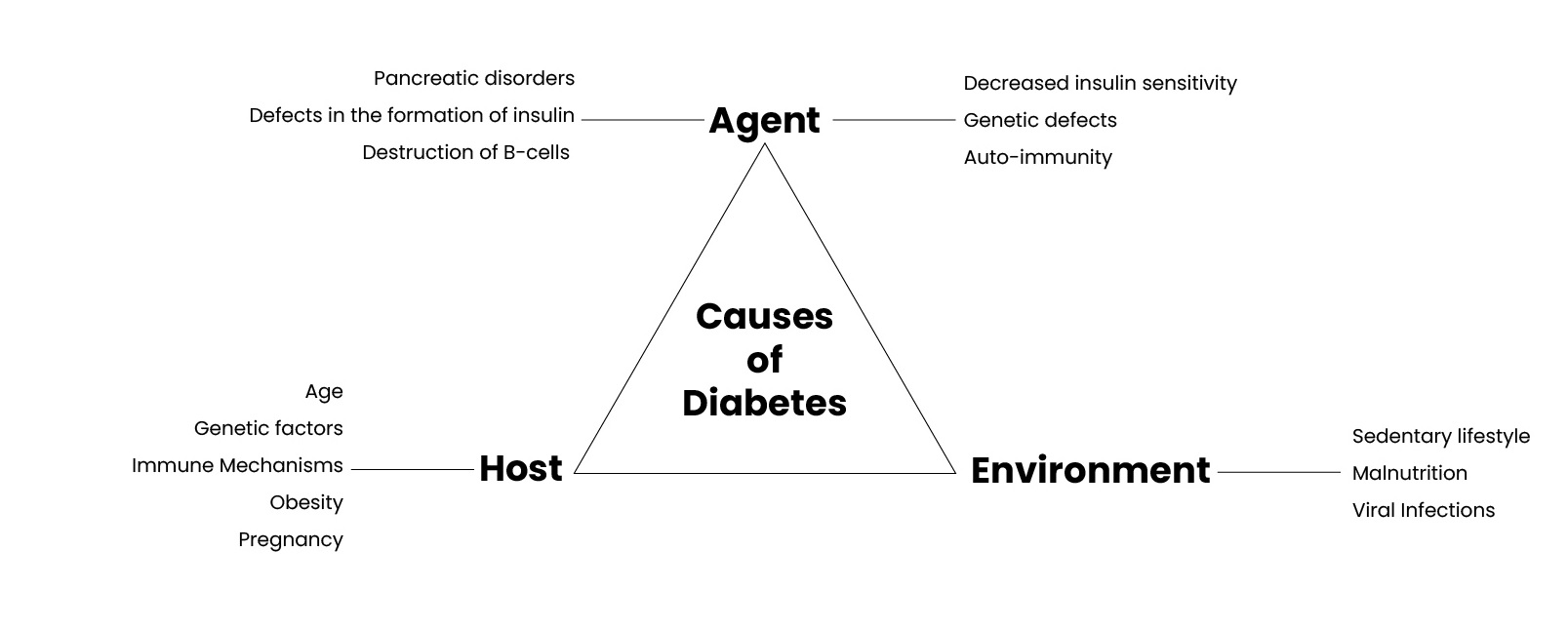
- Agent Factors
- Pancreatic disorders
- Defects in the formation of insulin
- Destruction of B-cells by viral infections and chemicals
- Decreased insulin sensitivity
- Genetic defects
- Auto-immunity
- Host Factors
- Age: Increased incidence with age
- Genetic factors: In Non-Insulin Dependent Diabetes Mellitus (NIIDM), concordance is about 90% in identical twins. In Insulin Dependent Diabetes Mellitus (IDDM), concordance is only 50%
- Immune Mechanisms: Both cell-mediated and humoral activity against islet cells
- Obesity: A risk factor for NIDDM
- Pregnancy: A risk factor for NIDDM
- Social and Environmental Factors
- Sedentary lifestyle
- Malnutrition in early infancy and childhood
- Viral Infections, for example, Rubella, Mumps, etc.
(B) Describe different sources of Renewable Energy. How is it helpful for the environment?
Question Breakdown:
The examiner, in this question, has simply asked you to highlight the resources of renewable energy resources. The very first and foremost thing that you need to do is to define Renewable energy resources. When done, explain your answer by defining each source in one to two lines. Then, more to the next part of your question that demands the utilization of renewable energy resources for the environment. In other words, advantages are asked. Remember, being creative is what will award you maximum marks on your GSA paper. Lastly, you can draw a schematic diagram in this question if you can.
Answer:
Renewable Energy Resources:
As the name explains, the sources of energy which, on usage, can’t be lost forever but can be recycled and replenished are called renewable energy resources. They are eco-friendly and do not cause much pollution in the atmosphere. The five major sources of renewable energy are
- Solar Energy
It is a type of energy generated by the Sun, which is harnessed from the Sun’s radiation using solar panels, converting it into electricity or heat for various applications, including powering homes and businesses.
For Example, In Pakistan, various solar energy systems are working, including Quaid-e-Azam Solar Park Bahawalpur.
- Wind Energy
In this form, energy is generated by harnessing the kinetic energy of moving air-wind- using wind turbines to produce electricity.
For Example, Jhimpir Wind Power Plant, Gharo Wind Power Plant, Bin Qasim Wind Power Project, etc.
- Hydropower Energy
Hydropower energy is generated by the gravitational flow of water, often through dammed rivers or waterfalls, which drives turbines to produce electricity.
For Example, Thakot Hydropower Project, Bunji hydro power project, Phandar Hydropower Project, etc.
- Geothermal Energy
Here, energy is produced by tapping into the Earth’s natural heat from within the Earth’s crust, using it for heating buildings, generating electricity, and other applications.
For Example: Geysers Geothermal Complex, USA
Pakistan, despite having a large potential to produce geothermal energy, does not have any GTPP.
- Biomass Energy
It is a type of energy which is derived from organic materials, such as wood, crop residues, and waste, which are burned or converted into biofuels to generate heat, electricity, or transportation fuels.
For Example, Iron Bridge Biomass Power Plant (UK),Sanawan Biomass Power Plant (PK)
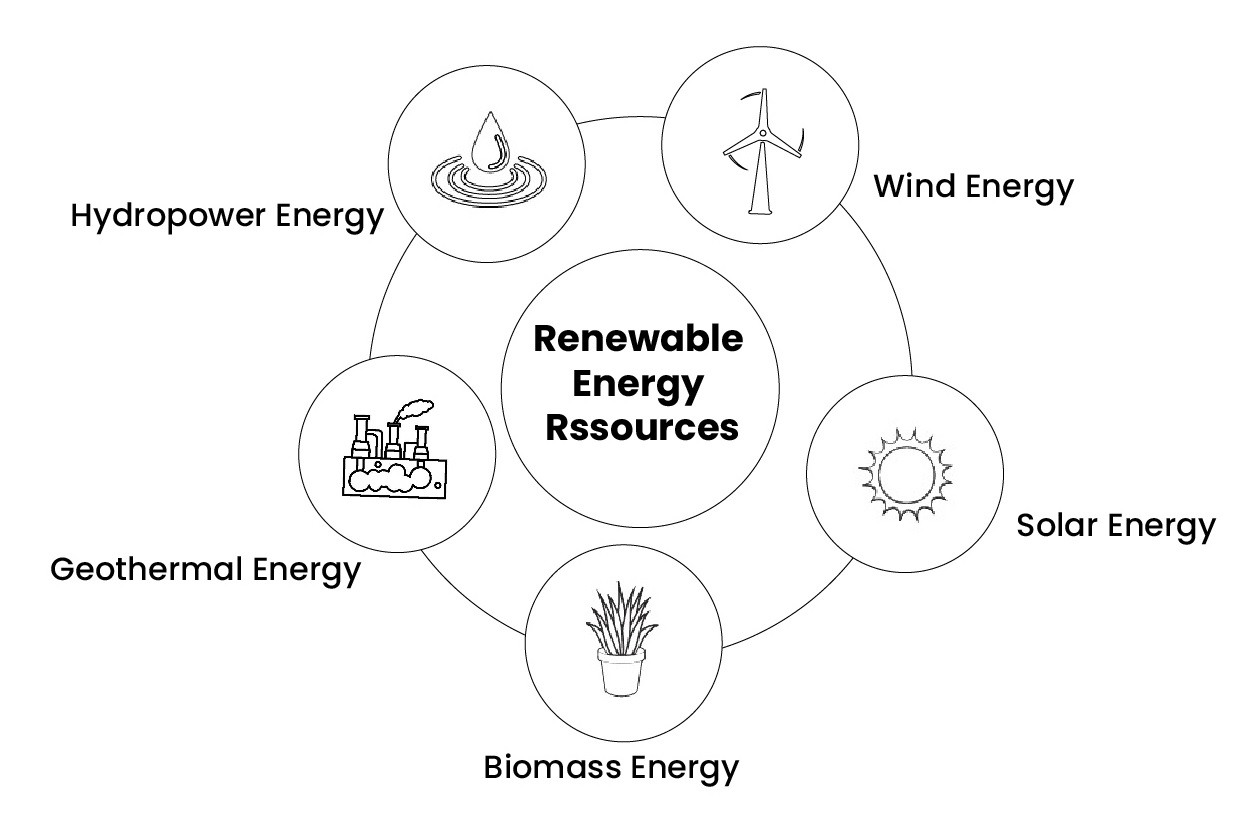
Benefits of renewable Sources for the Environment
“It’s time to stop burning our planet and start investing in the abundant renewable energy all around us.”
ANTÓNIO GUTERRES, United Nations Secretary-General
- Renewable sources produce electricity without emitting greenhouse gases, thus helping to mitigate climate change by reducing the carbon footprint and curbing global warming.
- Since renewable sources are sustainable, they help in preserving non-renewable resources like fossil fuels, protecting ecosystems and biodiversity.
- Energy produced by renewable resources creates less waste and fewer toxic byproducts, reducing the risk of land and water pollution.
- The use of renewables decreases air pollution by reducing the emissions of harmful pollutants like sulfur dioxide, nitrogen oxides, and particulate matter. This leads to cleaner and healthier air for people and ecosystems.
- Unlike conventional power generation, renewable energy sources do not require extensive water usage for cooling, reducing stress on water resources. Photovoltaic systems, used for generating electricity, have a minimal water footprint. Solar-thermal technologies may use local water resources for creating steam, but this water can typically be recycled after condensation.
The question has been asked multiple times in many previous papers: General Science and Ability Paper 2011, Question No. 5 (D), General Science and Ability Paper 2013, Question No. 5 (A), General Science and Ability Paper 2014, Question No. 4(B), General Science and Ability Paper 2019, Question No. 3(A), General Science and Ability Paper 2020, Question no. 2(D), General Science and Ability Paper 2021, Question no. 2(D). Thus, don’t forget to prepare this question thoroughly in all dimensions.
(C) Define ‘Enzymes’. Describe its types and functions within organisms.
Question Breakdown:
The question consists of three parts. In the first part, the examiner has asked you to define enzymes. So, do not forget to give examples along. To answer the next part, you are supposed to explain the basic types of enzymes. Draw a diagram here if possible. Last, explain four to five functions of enzymes in living organisms in bullets. Remember, try to keep your answer as simple as possible, avoid writing too much, and better work on your presentation.
Answer:
Define Enzyme:
Enzymes are the most important group of proteins which are biologically active. They are highly specific, each being responsible for a particular type of reaction. Since enzymes are responsible for catalyzing the reaction, without them, the reaction would proceed at a very slow speed, making life impossible.
Examples:
- Pepsin
- Sucrase
- Lipase
- Enterokinase
Types of Enzymes
There are six types of enzymes based on the types of biochemical reactions taking place in the body.

- Oxidoreductases facilitating oxidation reactions in which electrons move from one molecular form to another.
- Transferases aiding in the transference of functional groups between donor and acceptor molecules
- Hydrolases accelerating hydrolysis reactions by introducing water to break chemical bonds and induce hydrolysis
- Isomerases catalyzing changes in the structural arrangement of molecules, leading to alterations in their shape
- Lyases introducing water, carbon dioxide, or ammonia to disrupt double bonds or remove them to generate double bonds in molecules
- Ligases playing a role in catalyzing ligation processes, which are involved in the formation of chemical bonds.
Functions of Enzymes
Generally, the main function of enzymes is to speed up the reaction rate by attaching substrate (reactants) with the active site of the enzyme to form a Product; each type of enzyme is named according to the function it provides, as mentioned above. The general functions of enzymes are as follows.
- Enzymes, such as protein kinase, are pivotal in facilitating signal transduction processes, catalyzing the phosphorylation of proteins.
- Enzymes assist in breaking down large molecules into smaller, more easily absorbable substances, aiding in the body’s nutrient absorption.
- ATP synthase, a specific enzyme, is instrumental in the synthesis of energy, contributing to the body’s energy production.
- Enzymes are responsible for governing the movement of ions across the plasma membrane maintaining cellular balances.
- Enzymes carry out a wide range of biochemical reactions, including oxidation, reduction, hydrolysis, and more, facilitating the elimination of non-nutritive substances from the body.
(D) Describe the ‘Cell Structure’. Elaborate 7 main functions of a cell in human beings.
Question Breakdown:
In this question, the examiner has asked you to explain the structure of the cell and its seven main functions in human beings. To answer this, first, define the main jargon, that is, cell. Then, elaborate on the cell structure in a comprehensive way, along with a diagram. Then, elaborate on the seven main functions of cells in humans in bullet forms. Remember: answer your questions according to the marks distribution. More than the length of the content, creativity matters in your GSA paper.
Answer:
Define Cell
The term Cell is derived from the word “Cellula”, meaning “A Little Room.”
The basic structural and functional unit of life is called the cell. Generally, cells are microscopic and not visible to the naked eye. An organism may either contain one cell, known as a Unicellular Organism or contain many cells, known as a multicellular Organism.
Discovery of Cell
Initially, the cell was discovered by Robert Hooke in 1665 as an empty space bounded by a membrane. However, the discovery of the entire structure of the cell evolved with time.
Structure of Cell
Despite a few differences, all living cells are composed of three main parts.
- Nucleus
The nucleus is the main part of the cell, containing life and responsible for all activities of cells. In animal cells, it is located in the centre; however, in plant cells, it is pushed to the side due to a large central vacuole. Likewise, its size and numbers also vary from Cell to Cell, being spherical or irregular and mononucleate or multinucleate, respectively. The nucleus is further composed of a chromatin network, nucleoplasm, nucleoli, and nuclear membrane.
- Cytoplasm
The cytoplasm is one of the two living contents of cells, the second being the nucleus. It is mainly a part of the cell between the nucleus and cell membrane, containing soluble Cytosol and insoluble organelles and wastes. However, the numbers, sizes, and variety of organelles vary from cell to cell. For instance, animal cells lack plastids and chloroplast. Likewise, plant cells lack glycogen and centrioles. Others, like ribosomes, vacuoles and mitochondria, are present in both animal and plant cells.
- Cell membrane
The cell membrane, also known as the Plasma Membrane, is the outer boundary of the cell: outermost in the animal cell and covered by Cell Wall in plant cells. The cell membrane is mainly composed of lipids and proteins with a small amount of carbohydrates arranged in a mosaic manner, forming a fluid mosaic model.

The Function of Cells in the Human Body
- Cells are responsible for the structural organization of the human body. Many similar cells combine themselves to form tissues, organs, organ systems, and ultimately the whole beings.
- All the metabolic processes in the human body, such as respiration, digestion, and excretion to maintain homeostasis, is carried out by specialized cells.
- Cells generate energy through processes like glycolysis, the citric acid cycle, and oxidative phosphorylation taking place in the mitochondria of cells.
- Cells help eliminate waste products and toxins from the body to keep the body in balance and prevent damage.
- Cells perform the function of reproduction through DNA replication and passing it on to the next generation.
- The immune system of the body is controlled by cells through the identification and destruction of foreign invaders such as bacteria and viruses.
- The synthesis of all vital nutrients, for instance, protein, is done by cells in the human body, making it survive.
The same question has been asked in a different way in the General Science and Ability paper 2018, Question No. 3 (D). Therefore, do not forget to prepare that alone.
(SECTION-B)
Question no. 6
(A) Find the area of a rectangular field whose length is 20m and the length of its diagonal is 25m.
Answer
Data Given
Length of Rectangular Field = 20m
Length of Diagnol of Rectangular Field = 25m
To Find
Area of Rectangular Field = ?
Solution
As we know
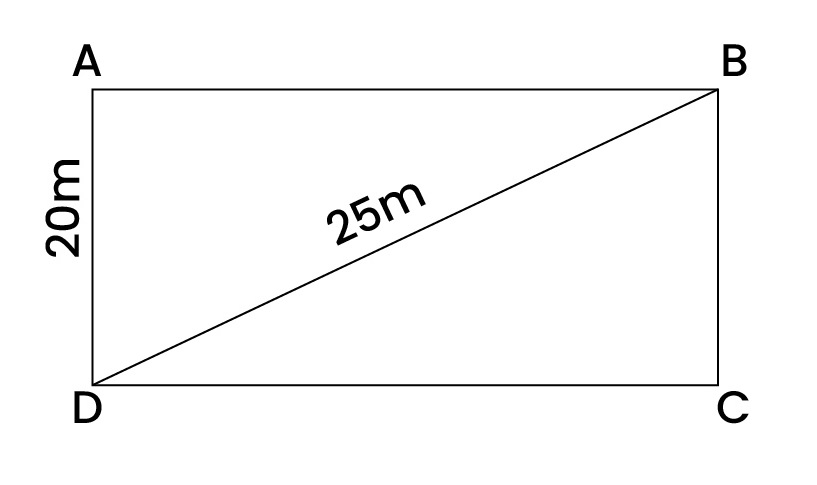
Opposite Sides of a rectangle are equal
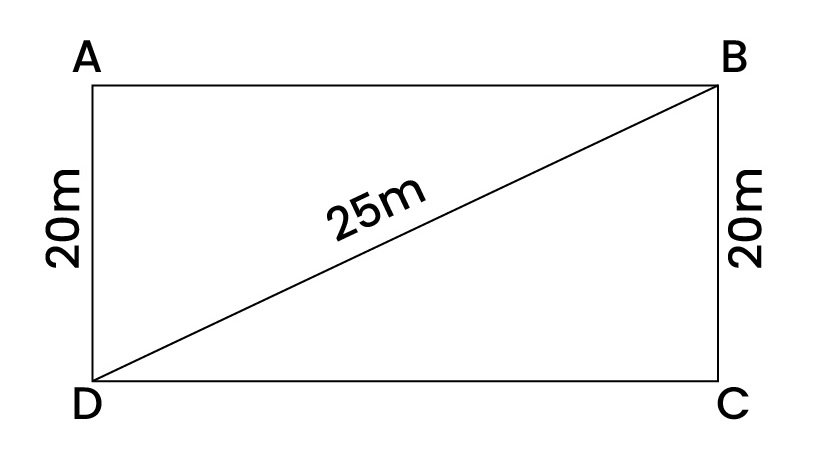
Also,
Area of Rectangle = Length × Width
To Find Width, we take a triangle out of it
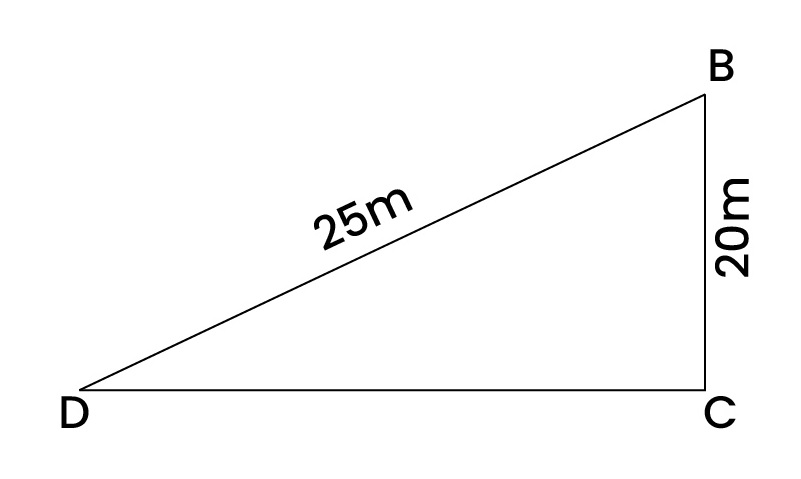

(B) A Crow travels 5 km due South, 3 km due West, 4 km due North and 2 km toward South-East. How far is the crow from its starting position?
There are two methods to solve this question
- Similar Triangle Method
- Vector Displacement Method
We will use vector displacement methods

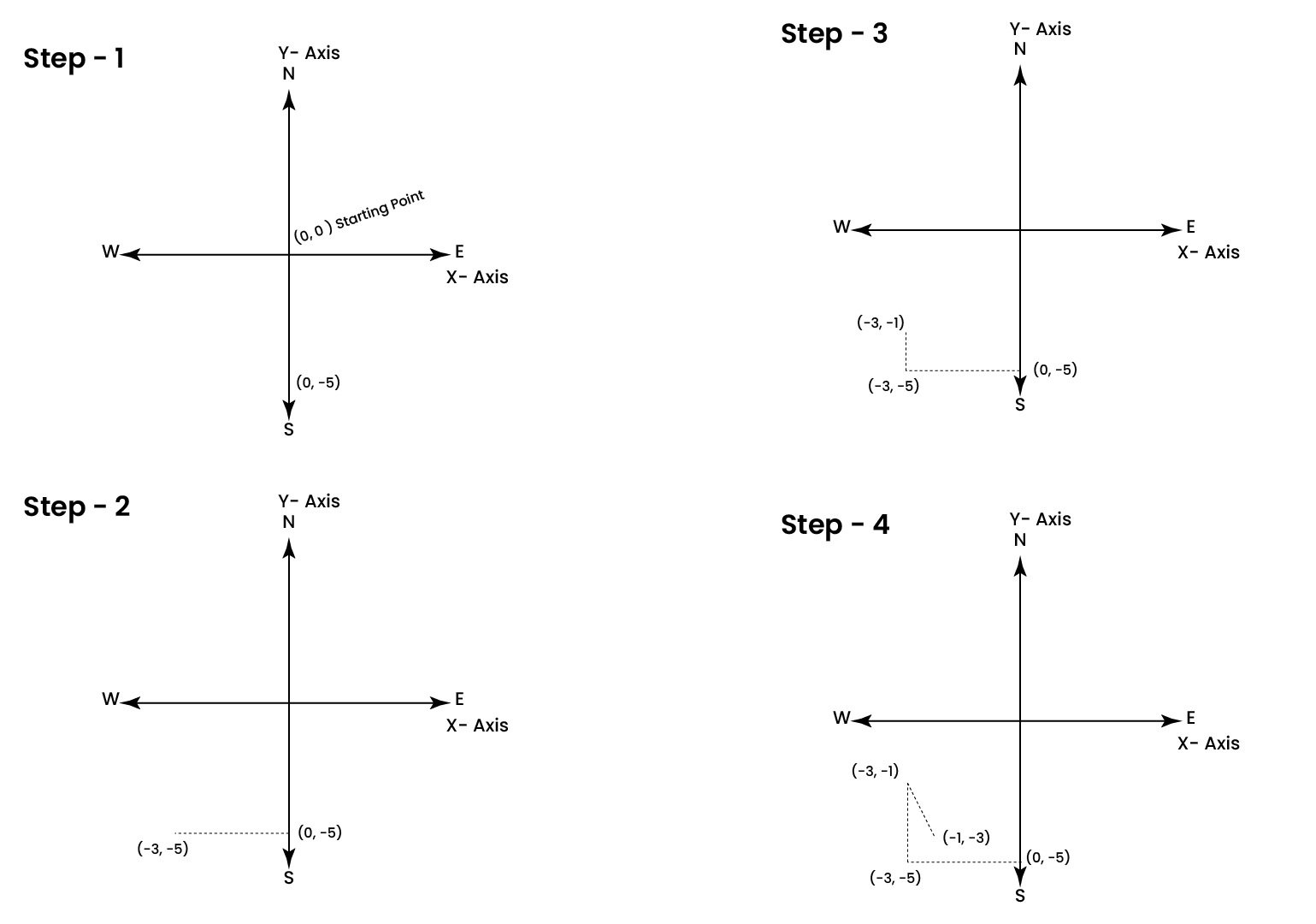
We have to find Displacement of (-1 -3) from (0, 0)

(C) Three persons, Zain, Ali and Umar started a business with Rs. 150,000, Rs. 190,000 and Rs. 120,000 respectivily. Zain manages the business and receives an allowance of Rs. 160,000 for this management. After 5 months Ali withdraws Rs. 90,000 and bussiness is closed after 9 months. What did Cach receive in the profit of Rs. 580,000?
Data Given
Business Started Initial Investment
Zain = Rs. 150,000
Ali = Rs. 190,000
Umer = Rs. 120,000
Zain Receives Allowances = Rs. 160,000
After five months, Ali Withdraws = Rs. 90,000
Total Profit = Rs. 580,000
To Find
Each share in Profit = ?
Solution
Zain allowances must be subtracted from profit
Remaining profit = Total Profit – Zain Allowances
= 580,000 – 160,000
= 420,000 Rs.
Zain Investment = Rs. 150,000
Time of Investment = 9 months
Zain investment in 9 months = 1,350,000 Rs.
Ali capital for 5 months = Rs. 190,000
After 5 months = 190,000 x 5
= 950,000 Rs.
Next 4 months = (190,000-90,000) x 4
= 400,000 Rs.
Total Investment after 9 months = 950,000 + 400,000
= 135,000 Rs.
Umar Investment = Rs. 120,000
After 9 months = 120,000 x 9
= 1,080,000 Rs.
Ratio of Their Investment
Zain : Ali : Umer
135,000 : 135,000 : 108,000
15 : 15 : 12
5 : 5 : 4
Total Parts = 5 + 5 + 4
= 14
Zain’s Share = Zain part/ Total parts x Remaining Profit
= 5/14 x 420,000
= 150,000 Rs.
Ali’s Share = Ali part/ Total parts x Remaining Profit
= 5/14 x 420,000
= 150,000 Rs.
Umer’s Share = Umer part / Total parts x Remaining Profit
= 4/14 x 420,000
= 120,000 Rs.
(D) Mst. Razia Begum died leaving behind her property of Rs. 802,500 which was to be (distributed among her husband, her mother and two daughters. The husband got 1/4, mother got 1/6 and remaining for 2 daughters. Rs. 7500 was spent on ber burial. Find the share of each one.
Data Given
Razia Begum Left Property = Rs. 802, 500
Husband’s Share = 1/4
Mother’s Share = 1/6
Expenditure on Burial = Rs. 7500
To Find
Share of one daughter = ?
Solution
The share divided between Husband and Mother is from what after subtracting amount spent on burial
Property Left = Total Property – Burial Money
= 802,500 – 7500
= 795,000 Rs.
Now find Husband Share
Husband share = Property left x Husband Part
= 795,000 x 1/4
= 198,750 Rs.
Mother’s Share = Property Left x Mother’s Part
= 795,000 x 1/6
= 132,500 Rs.
In order to find daughter’s share, we have to subtract mother and father share first from property left
2 Daughters share = Property left – Mother share – Father Share
= 795,000 – 132,500 – 198,750
= 464,000 Rs.
Share of one Daughter = 464,000/2
= 232,000 Rs.
Question no. 7
(A) In a certain country, 7% of the total workforce is employed in tourism. 24.4 million overseas visitors came to this country in 2014. 2014 was a record year for inbound tourism. This level of visitors was 3% higher than in 2013. It eclipsed the previous record of 24 million visitors recorded in 2008. In 2014 the average overseas visitor spent US$ 110 but average daily spend per visitor in 2013 was US $ 60 while in 2014, it was US$ 76.20. What percentage increase in daily average amount spent occurred between 2013 and 2014?
Data Given
7% of total workforce in tourism
Visitors of 2014 = 24.4 million
Change in tourism than 2013 = 3% increase
Previous Highest = 24 million (2008)
2014 Average Spent = $110
2013 Average Spent = $60

Increase in average spent is 83.33 %
May be, there is an error in question, the last spent is of 2008, if not, an be found using previous formula
(B) How many visitors came to this country in 2013?
Visitors came in 2013
Visitors in 2014 = 24.4 million
% increase = 3%
Same formula can be used

Therefore, visitors in 2013 = 26.689 million
(C) What was the approximate percentage increase on the previous record number of visitors?
% increase in previous record
Previous record = 24 million
New Record = 24.4 million
Same formula can be used to find this

(D) If there are 30 m people employed in this country’s workforce, how many work in the tourism sector?
Workforce in tourism sector = 7%
Total Workforce = 30 million
People in Tourism = ?
In order total number of workforce
People in tourism = 7% of 30 million
= 7/100 x30 million
= 21/10 million
= 2.1 million
Thus, People in Tourism Department = 2.1 million
Question no. 8
(A) The sum of two numbers is 48. If the smaller number is one-fifth of the larger number, find the two numbers.
Data Given
Two numbers sum = 48
Smaller number = 1/5 of larger number
If larger number = X
Smaller number = 1/5X
Then,
According to given condition
X = 1/5X = 48
6X/5 = 48
X = 48/6 x 5 = 40
Larger number = 40
Smaller number = 1/5 (40)
Smaller number = 8
Hence, the numbers are 8 and 40
(B) Find out the correct word from the jumbled spellings given
IUPNRT, AERPSTEL, LLARIVTTOUE, DCAAOOV, ANAISSSOITANS
Answer
- IUPNRT = TURNIP
- AERPSTEL = PLASTER
- LLARIVTTOUE = Ultraviolet
- DCAAOOV = AVOCADO
- ANAISSSOITANS = ASSASINATIONS
(C) A sphere of diameter 26 cm is half filled with honey. The honey is poured into a cylindrical beaker of diameter 16 cm. Find the depth of honey in the beaker.
Answer
Given Data
Diameter of sphere = 26cm
Sphere is half filled
Cylindrical Breaker Diameter = 16cm
To Find
Depth to be filled = ?
Solution
- Step 1

- Step 2

Thus, the depth of honey in beaker = 22.88cm
(D) The breadth, length, and height of a room is 14 feet, 20 feet and 10 feet respectively. There is also a door of room having height 8 feet and with 5 feet. Two windows of 4 feet by 5 feet are also there. The cost of paint and labour inside room is Rs. 100 per square foot. How much will it cost to paint the inner walls and roof of the room?
Answer
Data Given
Breadth of room = 14ft
Length of room = 20ft
Height of room = 10ft
Height of door = 8ft
Alter height = 5ft
2 Windows = 4 x 5
Cost of Labour = Rs. 100/ft2
To Find
Total Cost to paint inner walls and roof = ?
Solution
In order to find the cost, we need to find the area of wall and area of roof
After finding the area of both, we have to subtract area of 1 door and 2 windows.

Area of Wall
2 Sides wall as shown is
2 (Breadth x Height) = 2 (14 x 10)
= 280 ft2
Other two sides of wall
2(Length x Height) = 2 (20 x 10)
= 400 ft2
Area of roof = Length x Breadth
=20 x 14
= 280 ft2
Total Area = Area of Wall + Area of Roof
= 280 + 400 + 280
= 960 ft2
Area of Door = 8 x 5 = 40 ft2
Area of windows = 2 (4 x 5)
= 40 ft2
Area to be painted = Total Area – Area of Door – Area of window
= 960 – 40 – 40
= 880 ft2
Cost per square ft = Rs. 100
Area to be Painted = 880 ft2
Cost of Total Area = 880 x 100
=88,000 Rs.
So, the cost to paint walls and roofs = 88,000Rs.
CSS Solved Past Papers’ Essays
Looking for the last ten years of CSS and PMS Solved Essays and want to know how Sir Kazim’s students write and score the highest marks in the essays’ papers? Then, click on the CSS Solved Essays to start reading them.
CSS Solved Essays
CSS Solved General Science & Ability Past Papers

Articles Might Interest You!
The following are some of the most important articles for CSS and PMS aspirants. Click on any to start reading.












